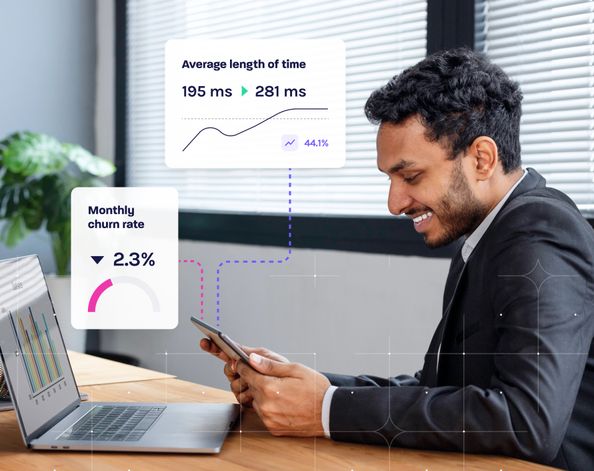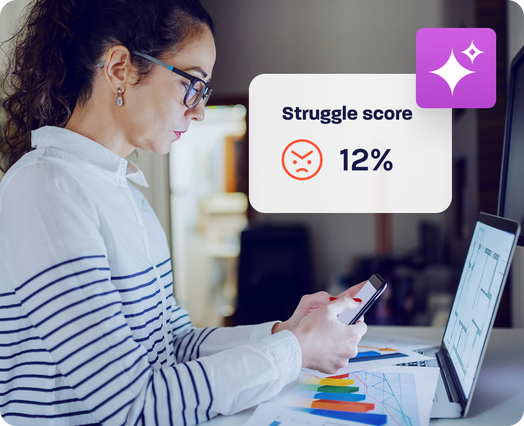
Top 12 Mobile App Metrics You Need To Track
Mobile app metrics are measurable indicators that track how users interact with an app and how well the app performs. They provide insights across key areas such as acquisition, engagement, retention, conversion, performance and revenue. By tracking these metrics, developers and product teams can uncover friction points, refine the user experience and make data-driven decisions that drive both app success and customer satisfaction. In short, these metrics are vital not just for app performance, but for creating experiences that keep users coming back.
In October 2025, mobile devices accounted for about half of global web traffic (excluding tablets) and by 2024, 64% of online users preferred an app over a website.
Why does this matter? Mobile devices serve as the primary platform for mobile apps, which continue to grow at an astonishing rate. There are nearly nine million apps worldwide, with approximately 255 billion downloads as of January 2025. These mobile apps are projected to generate more than $613 billion in revenue in 2025 alone.
With such high stakes—both in revenue and user attention—companies need to ensure their apps are optimized to deliver a standout user experience (UX) and cut through the crowded marketplace. This article dives into the top mobile app metrics you need to track, showing how measuring the right data can help you boost engagement, improve retention and maximize your app’s success.

Key Mobile App Information for 2025
The mobile app market is expected to reach about $740 billion by 2033, a significant increase from about $259 billion in 2024.
In 2024, users spent a total of 4.2 trillion hours in apps globally.
On average, each user now spends 3.5 hours per day using mobile apps.
The average number of apps used per person per month is about 26.
Data security and privacy are top concerns for mobile apps as apps collect sensitive user information—contacts, location, financial data and personal preferences—requiring developers to comply with regulations like CCPA and GDPR, implement strong encryption, and provide secure storage.

With so much competition and revenue potential at stake, companies with mobile apps need to continually ensure their platforms are optimized to deliver a stand-out user experience (UX) and cut through the noise.
By Tracking the 12 Essential Mobile App Metrics in This Blog, You Can:
Understand how your mobile app is being used so you can fully optimize it to create positive user experiences
Identify new opportunities to keep users coming back
Uncover pain points that are potentially driving uninstalls and users away
What Are Mobile App Metrics?
📈 Mobile app metrics measure actions taken while users engage with the platform—be it a web, native or hybrid app. There is a wide range of metrics to measure to effectively gauge how users experience the app so you can ultimately improve the UX and boost customer engagement, acquisition, conversion, retention and revenue generation.
Why Are Mobile App Metrics Important?
Mobile app metrics provide a window into the performance of your app, revealing pain points that could drive uninstalls and opportunities to keep users coming back. Tracking key mobile app metrics and quickly taking steps to remedy any issues you identify can prevent customers from forming a negative opinion of your brand. With so many apps to choose from, a poor user experience is sure to drive customers elsewhere.
How To Successfully Track Mobile App Metrics
There are a variety of stand-alone mobile app analytics platforms that brands can use to track metrics. However, stand-alone analytics solutions have limitations. They can tell you what happened, but they can’t deliver a holistic picture that also tells you why users behaved the way they did. That’s why it’s important to have a digital experience intelligence (DXI) platform that provides a complete picture, pulls all your mobile app data into one place and turns information into actionable insights.
👉Check out this handy list of mobile app analytics tools to help get you started.
Key Mobile App Analytics Metrics To Track
The goal of any app development project is to keep the app on consumers’ smartphones and users engaged. That can be a tall order with consumers who have little patience for technical glitches and millions of other choices. Staying on top of these key mobile app metrics will put you ahead of the game.
We've outlined 12 mobile app metrics that are critical to product managers, production engineers and UX experts, and explain how to calculate them below.
Acquisition Metrics
1. User Acquisition (UA)
User acquisition measures the number of new installs generated by campaigns or promotional offers. This metric tracks where new users come from and how campaigns drive installs. This metric is relevant to:
Product managers who track user acquisition sources to optimize marketing campaigns and allocate budget effectively. For example, they may invest more in high-performing channels or explore new acquisition opportunities.
Production engineers who monitor how user acquisition may impact technology. They assess user acquisition data to prepare for potential server load increases and maintain app performance.
UX experts who evaluate user acquisition channels to understand how different user segments engage with the app. They use this information to tailor the user experience accordingly.
How To Measure User Acquisition
User acquisition cost = (cost of sales + cost of marketing) / new users acquired
2. Downloads (Installs)
A download is a net-new installation of an application on a mobile device—downloads and installs are the same thing. Apps are downloaded from app stores such as the Apple App Store or Google Play Store. This metric—considered a vanity metric if used alone—measures initial user interest and is useful to:
Product managers who need to track the number of app downloads to gauge the effectiveness of marketing campaigns, app store optimization and feature updates. For example, if a spike in downloads occurs right after a promotional event, that could indicate the campaign was successful.
Production engineers who need to evaluate downloads from a different lens. They monitor downloads to anticipate server load and infrastructure requirements to ensure smooth app performance. If downloads don’t meet performance expectations, that could signal problems on the technical end.
UX experts who have a different vantage point. They evaluate the impact of app store listing changes (e.g., app icons, screenshots, descriptions) on download rates. If downloads are lower than expected, they evaluate and make improvement recommendations.
How To Measure Downloads
Track net-new installs via app store analytics.
Engagement Metrics
3. Daily Active Users (DAU) and Monthly Active Users (MAU)
DAU and MAU identify how many users are active daily and monthly (user engagement) and app stickiness. Defining an “active user” is up to you–it could mean logging into the app or using a specific feature within the app. This metric is useful to:
Product managers who use active user metrics to measure user base growth, product-market fit and engagement patterns. For example, they should compare the ratio of DAU to MAU to industry benchmarks to assess app stickiness. A DAU/MAU ratio of 20% is considered good, while a ratio below indicates improvement is needed, and a ratio above signals a successful app.
Production engineers who want to ensure the technology stack can handle a potential spike in usage. They need to monitor active users closely so they can allocate resources effectively and handle periods of increased activity thatlead to peak loads.
UX experts who need to monitor active users to identify positive or negative trends. They investigate fluctuations in active user levels so they can identify potential UX issues that are impacting app use and find opportunities for improvement.
How To Measure DAU and MAU
To calculate DAU and MAU, you need to set your product analytics tool to track a specific event that makes someone an active user. Your tool will then track how many users complete the action on a daily or monthly basis.
4. In-App Engagement
An especially important metric, in-app engagement helps you understand how users interact with your mobile app through likes, shares, comments, views, etc. This metric is helpful to:
Product managers who track in-app engagement metrics to understand user preferences and inform content or feature updates. For example, if users frequently share a specific type of content, they could consider promoting it more prominently or creating similar content.
Production engineers who view in-app engagement from the technology end, monitoring it to ensure the app infrastructure supports high levels of user interaction without causing performance issues.
UX experts who use in-app engagement data to identify opportunities for improving user interactions, such as simplifying content sharing or refining comment functionality.
How To Measure In-App Engagement
You can best measure in-app engagement by looking at DAU and MAU, retention rate, churn rate and average session length.
5. Average Session Length
This is the average amount of time users spend on your mobile app. Since not all apps are intended to be used daily, you’ll need to define what an active user is as it relates specifically to your app. This metric, which is also a good performance metric, is helpful to:
Product managers who are analyzing average session length to assess user engagement and the effectiveness of content or feature updates. For example, increased session lengths after a content update could indicate high user engagement and positive user response.
Production engineers who are focusing on average session length so they can troubleshoot potential technical issues going forward. They monitor session length to understand server load, optimize app speed and identify potential crashes or error-prone areas.
UX experts who are continually looking to identify opportunities to improve user flow, navigation or content consumption. To do this, they monitor average session length to identify and investigate session length patterns.
How To Calculate Average Session Length
The average session duration = the total duration of all sessions (in seconds) / number of sessions
(Source: Google)
6. Session Interval
This is a measurement of the time between two consecutive sessions or visits of a customer using your mobile app. This metric is useful to:
Product managers who use session interval data to inform strategies for driving mobile app user engagement. Some tactics that product managers use to decrease session interval time are push notifications, in-app messaging or content updates.
Production engineers who are on the lookout for how session intervals will impact technology decisions. They monitor session intervals to anticipate resource demands and maintain optimal app performance.
UX experts who study session intervals to uncover user behavior patterns and pinpoint UX improvements that can motivate users to return more often.
How To Calculate the Session Interval
Average session interval = total session interval time / number of sessions
7. Screen Flow
This shows you the exact path or flow that users take directly within your app. This metric, which is also a good performance metric, is helpful to:
Product managers who identify popular user flows and drop-off points to guide app feature development and improve user satisfaction. For example, if users frequently abandon the app during the checkout process, product managers should consider streamlining the flow.
Production engineers who are analyzing screen flow data to evaluate system performance and confirm that key app paths are running optimally to maintain a seamless user experience, and avoid slowdowns, errors or crashes.
UX experts who want to provide the best user experience. They analyze screen flow to identify usability issues, such as confusing navigation or unintuitive interactions, and propose design improvements.
How To Measure Screen Flow
A DXI platform, such as Glassbox, can help you see the paths users are taking on your app and understand why drop-offs and deviations happen.
Retention Metrics
8. Retention Rate
Retention rate is the number of users who revisit your app at least once after installing it over a certain period of time. Typically, the retention rate is measured on a monthly, quarterly or yearly basis. This metric is useful to:
Product managers who need to understand whether their work is driving strong retention and loyal users. They use retention data to evaluate the app’s long-term value and to prioritize features. For instance, if a particular feature shows high retention, it may merit additional investment.
Production engineers who view retention rates from a technical perspective. They track and assess how infrastructure or technology performance improvements, including app speed, load times, crashes and error rates, can affect retention rates and grow user loyalty.
UX experts who are analyzing retention rates to identify any friction points in the user experience that may cause users to abandon the app. Some of the most common app friction points are overly complicated onboarding steps or frequent app crashes.
How To Calculate Retention Rate
Retention rate = (active users at the end of period / active users at the start) x 100
9. Churn Rate
Churn rate is the exact opposite of retention rate and measures the rate at which users uninstall your app or downgrade and/or cancel their subscriptions. High churn rates can be detrimental to a business’s success, so it’s critical to keep a close watch on them. This metric is helpful to:
Product managers who are monitoring churn rates, also known as abandonment rates, to evaluate the app's ability to retain users. Keeping an eye on churn rates can guide strategies for reducing user attrition, such as targeted re-engagement campaigns or loyalty programs. Check out these churn rate benchmarks to see how you stack up.
Production engineers who are investigating potential technical issues such as slow load times, crashes, app errors or performance bottlenecks that may contribute to churn.
UX experts who are the problem seekers and solvers in the app world. They identify UX pain points, such as a high churn rate, that could be driving users away from the app. They also propose design improvements to minimize churn.
About 50% of users uninstall apps within 30 days, and about 25% of users abandon an app after just one use.
How To Calculate Churn Rate
Churn = (users at start of month* – users at end of month) / users at start of month x 100
*You can substitute “month” for the specific period of time you’re looking to measure.
Conversion Metrics
10. Conversion Rate
A conversion rate is the percentage of users who completed a desired action compared to the total number of visitors. The higher the conversion rate, the better the conversion rate optimization achieved. This metric is helpful to:
Product managers who monitor conversion rates for key app goals (e.g., sign-ups, purchases or content sharing) to evaluate the effectiveness of features, promotions and user flows. For example, they may test different pricing strategies or promotional offers to improve purchase conversions.
Production engineers who are assessing conversion rates to optimize app performance and reduce technical barriers that may impact conversion rates, such as slow loading screens, app crashes, speed issues, or error messages.
UX experts who are investigating conversion rates and addressing UX-related conversion barriers—such as confusing CTAs or complex forms—to improve user flow and conversion rates.
How To Calculate Conversion Rate
Conversion rate = number of conversions / total visitors x 100
Revenue Metrics
11. User Lifetime Value (LTV)
LTV measures how much revenue a user generates for your business over the entire span of their relationship with your mobile app. This metric is helpful to:
Product managers who are using LTV data to inform their customer acquisition and retention strategies. For users with a high LTV, product managers may consider adjusting acquisition budgets or targeting high-value user segments with personalized offers.
Production engineers who are looking at the technical side, monitoring LTV so they can evaluate and forecast the impact of infrastructure improvements or optimizations on long-term user engagement and revenue.
UX experts who are analyzing LTV to understand how UX improvements contribute to increased user engagement, satisfaction and revenue generation, and what improvements may be needed going forward.
How To Calculate LTV
LTV = average revenue per customer x average customer lifetime
Vanity Metrics
12. App Ratings and Reviews
App ratings and reviews are categorized as a mobile app analytics metric. App ratings and reviews influence potential users on whether they want to install the app on their smartphones. This metric is useful to:
Product managers who are monitoring app store ratings and reviews to understand user satisfaction, identify areas for improvement and address user concerns. This information helps them respond to reviews to demonstrate active engagement and commitment to user satisfaction.
Production engineers who are using feedback from reviews to identify and resolve technical issues that may be impacting user experiences, such as bugs or performance problems.
UX experts who are analyzing user feedback from reviews to identify user experience pain points and prioritize design improvements to create a more user-centric experience.
These 12 mobile app metrics give teams the clarity they need to improve performance, deepen engagement and build experiences users value. With the right data and the right tools, small optimizations can compound into long-term app growth.
Mobile App Metrics FAQs
What Is a Mobile App KPI?
Mobile app KPI, or key performance indicator, is another term used for the metrics that measure how well your app runs. These include load time, responsiveness, errors and app crashes. Strong performance reduces friction, improves the app experience and supports retention. Tracking these mobile app performance metrics alongside engagement data helps teams quickly spot issues that affect user satisfaction and revenue.
What Are the Most Important Mobile App KPIs to Track?
Core mobile app KPIs include active users, retention, churn, conversion rate and user lifetime value. Each key performance indicator reflects a different stage of the user journey. Product teams often supplement these with additional key metrics like onboarding completion or feature adoption to better measure app success.
How Do I Measure Mobile App Engagement and User Behavior?
Use app engagement metrics such as session length, screens per session, event activity and feature usage. To understand deeper user behavior, review funnels, screen flows and paths that show where users drop off or repeat steps. Combining engagement and journey data helps teams improve flows and increase app usage.
What Is a Good DAU/MAU Ratio for a Mobile App?
The daily active user to monthly active user ratio (DAU/MAU) reflects app stickiness. Many products consider 20% or higher a healthy benchmark. Tracking this over time reveals how frequently active users, app users and unique users return, helping teams identify opportunities to strengthen engagement.
Deliver Mobile Experiences Your Customers Love and Keep Them Coming Back
Mobile app metrics help teams understand how their app is being used so they can improve their user interface, prioritize feature development, fix crashes and optimize performance. The data can also help identify new opportunities.
Want to learn more? Check out The Ultimate Guide to Optimizing Mobile Apps.







